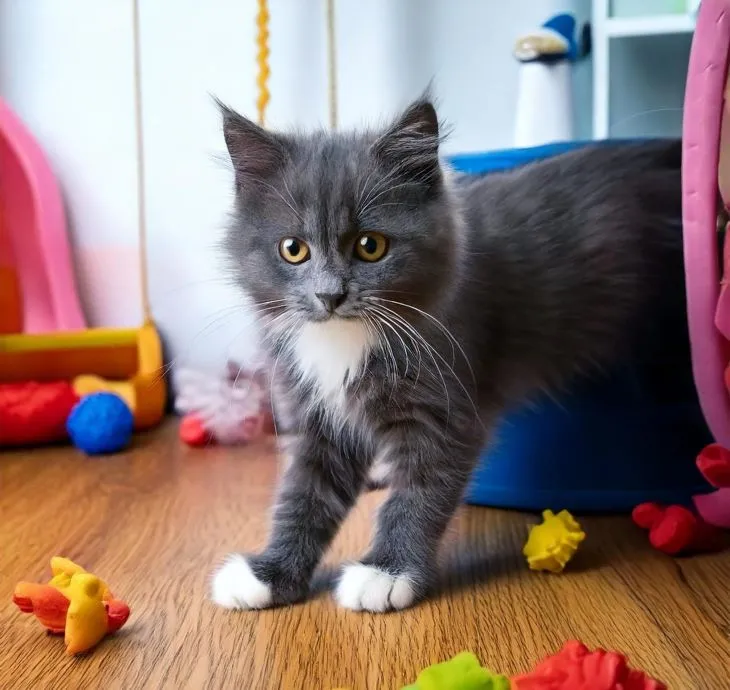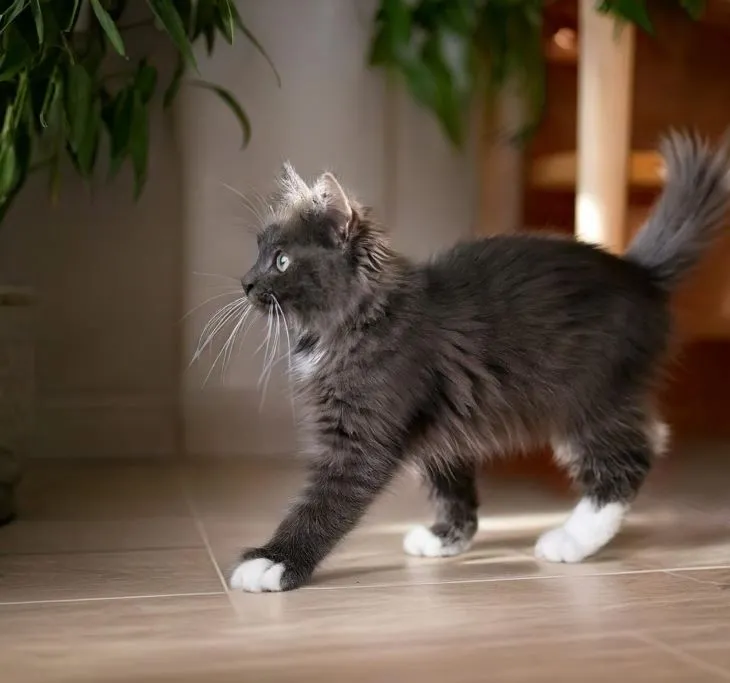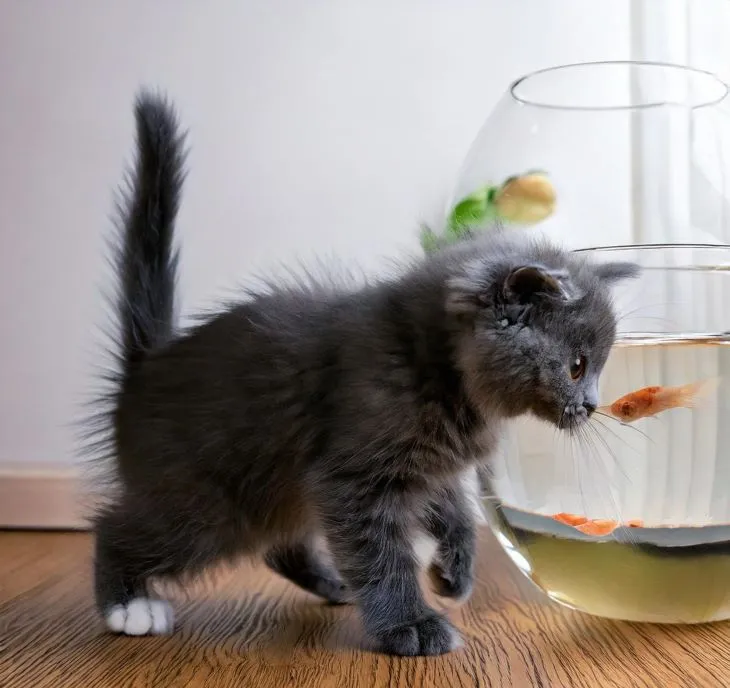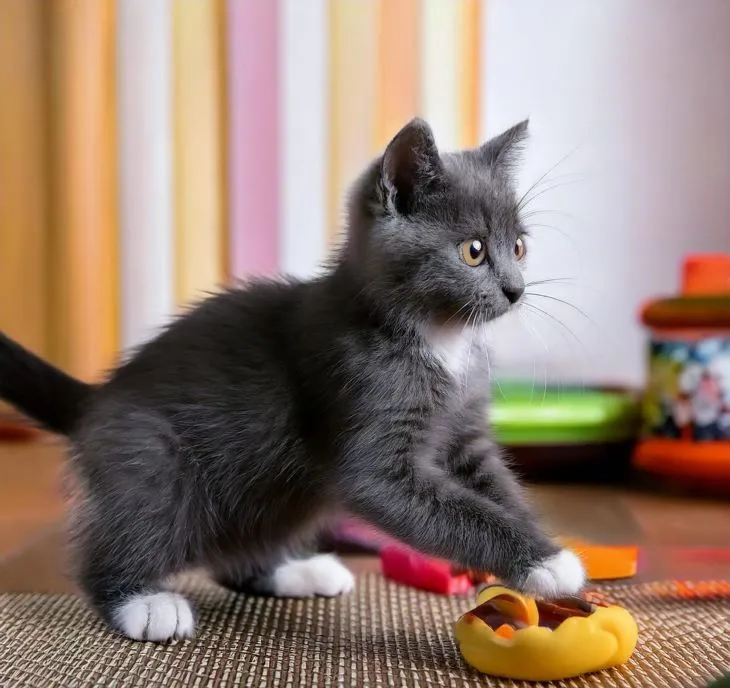Fever Coat In Kittens: What It Is, Effects & Types
By: Elizabeth Rikas

The information in this article is intended to educate cat parents and is not a substitute for veterinary guidance. In case of any concerns about your cat’s health, please talk with your veterinarian.
If your kitten has an unusual silvery or faded coat, don’t worry! This captivating phenomenon, known as a fever coat, is a temporary and harmless color variation caused by unique circumstances in the mother cat’s pregnancy. Learn what causes fever coat, how long it lasts, and how to care for your kitten during this remarkable phase.
What Is Fever Coat In Kittens?
Fever coat is a rare, natural condition that affects some kittens’ fur, giving them a faded or silvery appearance at birth. This happens when the mother cat experiences stress, fever, or illness during pregnancy. As a result, the developing kitten’s pigmentation process is temporarily disrupted, leading to a unique fur color that usually fades as the kitten matures, revealing its true genetic coloring.
Click to read: Why do cats gag?
What Causes Fever Coat ? Should I Be Worried
The unusual coloring in a fever coat kitten is due to changes in pigment deposition in the womb. When a mother cat experiences:
- High stress or illness
- Fever during pregnancy
- Hormonal or environmental changes
These factors can interfere with pigment production, causing lighter or silvery tones in the kitten’s coat. Fever coat does not indicate any health issues in the kitten itself; instead, it reflects conditions during prenatal development.
How To Identify Fever Coat In Kittens

Kittens with fever coats display distinctive fur colors, often in shades that differ from their expected genetic colors. Here’s how to recognize it:
- Color and Texture: The fur may appear silvery, cream, or even gray, with the tips often frosted or lighter than the roots. Some kittens may have a smoky or dusty look, especially those expected to have darker coats.
- Pattern Differences: The face, paws, and tail might hint at the kitten’s true color, giving a unique two-toned or “silver jacket” look.
- Temporary Appearance: Fever coats usually begin to fade around the 4-8 week mark, revealing the true fur color as the baby fur sheds and new growth comes in.
Interesting Read: Exotic Longhair
How Fever Coat Affects Different Colors Of Kittens
Each fever coat can look distinct depending on the kitten’s genetics:
- Black kittens may appear silvery-gray or reddish.
- Gray or blue kittens might look silver or white.
- Tabby kittens might have muted or faded markings, with only faint stripes visible.
While these colors are stunning, they are only temporary.
How Long Does A Fever Coat Last?

Most fever coats will start to fade as early as 4-8 weeks:
- Early Months: The kitten’s coat begins to shed, and new growth comes in with its natural, genetic color.
- 4-6 Months: By this age, much of the fever coat will have faded, with the true color emerging.
- 1 Year: By their first birthday, most kittens will display their final coat color, matching their genetic makeup.
This gradual change allows pet owners to watch as their kitten’s coat transitions into its natural beauty.
Types Of Fever Coat
Fever coats can vary, with different patterns and colorations:
All-Over Color
Most common, with a silver or creamy tone over the entire body. The real color may be visible near the roots or skin.
Patchy
Some kittens have mixed color zones—like a silver body with a darker face or paws, hinting at their future coloring.
Stripes
Rare but unique, with light-colored stripes along the back, resembling faint tabby markings in a silver tone.
Spot the difference between Male vs Female Cats
Myths and Misconceptions About Fever Coat
Misunderstandings about fever coat can lead to confusion. Here are common myths clarified:
- Fever Coat Indicates Illness: Fever coat is not a sign of sickness. It results from conditions during the mother’s pregnancy and is harmless to the kitten.
- The Color Is Permanent: Fever coat is temporary. The true genetic color will gradually emerge as the kitten grows and sheds its baby fur.
- It’s Extremely Rare: Fever coats are uncommon but not exceedingly rare. Many breeders and rescue centers have seen it occasionally.
Click to know: Can Cats Eat Raw Meat?
How To Care for A Fever Coat Kitten

Caring for a fever coat kitten doesn’t require any special treatment. Basic kitten care routines will support their healthy development:
- Nutrition: Ensure the kitten has a balanced diet with quality kitten food to support growth.
- Regular Vet Visits: Routine check-ups help monitor their health as they grow.
- Stress-Free Environment: Create a calm and nurturing space to support their development.
- Grooming: Regular brushing maintains their coat, even if it’s temporarily silvery or faded.
Understanding that fever coat is a natural, harmless condition helps pet parents appreciate their kitten’s unique appearance without concern.
Click to know: How to litter train a kitten?
Frequently Asked Questions
Conclusion
Fever coat is one of nature’s delightful mysteries, offering kittens a temporary, magical appearance. As they grow and their true colors emerge, fever coat in kittens remind us of the unique beauty and wonder in our feline friends. This fascinating phase in a kitten’s life doesn’t last forever but offers a glimpse into the delicate dance of genetics and development. With love, care, and patience, fever coat kittens will grow into vibrant, happy cats.

About the Author
Elizabeth Rikas
Elizabeth is a passionate advocate for feline health and well-being, drawing from her years as a dedicated pet parent to three cats—Gypsy, Swan, and Alfred—and her invaluable experience volunteering at animal shelters. A seasoned writer with a lifelong love for cats, Elizabeth began sharing her insights in her teens and has since contributed extensively to platforms focused on feline care. Through her expertise and heartfelt dedication, she empowers pet owners with practical advice and research-backed knowledge to nurture their furry companions.
